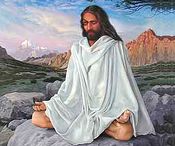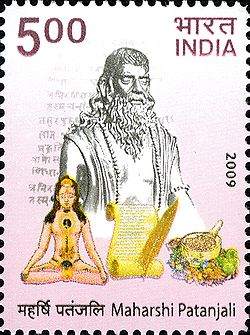Patanjali
| Author: Dayanand Deswal दयानन्द देसवाल |
Patañjali (Sanskrit: पतञ्जलि) is a proper Indian name. Several important ancient Sanskrit works are ascribed to one or more authors of this name, and a great deal of scholarship has been devoted over the last century or so to the issue of disambiguation.[1]
Works
Amongst the more important authors called Patañjali are:[2][3]
The author of the Mahābhāṣya, an ancient treatise on Sanskrit grammar and linguistics, based on the Aṣṭādhyāyī of Pāṇini. This Patañjali's life is dated to mid 2nd century BCE by both Western and Indian scholars.[4] This text was titled as a bhasya or "commentary" on Katyayana-Panini's work by Patanjali, but is so revered in the Hindu traditions that it is widely known simply as Maha-bhasya or "Great commentary". So vigorous, well reasoned and vast is his text, that this Patanjali has been the authority as the last grammarian of classical Sanskrit for 2,000 years, with Panini and Katyayana preceding him. Their ideas on structure, grammar and philosophy of language have also influenced scholars in other Indian religions such as Buddhism and Jainism.[5]
The compiler of the Yoga sūtras, a text on Yoga theory and practice,[10] and a notable scholar of Samkhya school of Hindu philosophy.[11][12] He is variously estimated to have lived between 5th century BCE to 4th century CE, with more scholars accepting dates between 2nd and 4th century CE. The Yogasutras is one of the most important texts in the Hindu tradition and the foundation of classical Yoga. It is the Indian Yoga text that was most translated in its medieval era into forty Indian languages.
The author of a medical text called Patanjalatantra. He is cited and this text is quoted in many medieval health sciences-related texts, and Patanjali is called a medical authority in a number of Sanskrit texts such as Yogaratnakara, Yogaratnasamuccaya and Padarthavijnana.[6]
There is a fourth Hindu scholar also named Patanjali, who likely lived in 8th-century CE and wrote a commentary on Charaka Samhita and this text is called Carakavarttika.[7]
According to some modern era Indian scholars such as P.V. Sharma, the two medical scholars named Patanjali may be the same person, but completely different person than the Patanjali who wrote the Sanskrit grammar classic Mahabhasya.[8]
Life
Louis Renou was among the many scholars who have suggested that the Patañjali who wrote on Yoga was a different person than the Patanjali who wrote a commentary on Panini's grammar.[9]
In 1914, James Wood proposed that they were the same person.[10]
In 1922, Surendranath Dasgupta presented a series of arguments to tentatively propose that the famed Grammar text and the Yoga text author may be identical.[11]
Some in the Indian tradition have held that one Patañjali wrote treatises on grammar, medicine and yoga. This has been memorialised in a verse by Bhoja at the start of his commentary on the Yogasutras called Rājamārttanda (11th century), and the following verse found in Shivarama's 18th-century text:[12]
- योगेन चित्तस्य पदेन वाचां मलं शरीरस्य च वैद्यकेन। योपाकरोत्तं प्रवरं मुनीनां पतञ्जलिं प्राञ्जलिरानतोस्मि॥
English translation: I bow with my hands together to the eminent sage Patañjali, who removed the impurities of the mind through yoga, of speech through grammar, and of the body through medicine.
गोनर्द
गोनर्द पाली ग्रंथ 'सुत्तनिपात' के अनुसार विदिशा तथा उज्जयिनी के मार्ग के बीच में स्थित एक नगर था। इस नगर को शुंग काल के उद्भट विद्वान् पतंजलि का जन्म स्थान माना जाता है। पतंजलि की माता का नाम 'गोणिका' था। ये 'योग दर्शन' तथा पाणिनि के व्याकरण के 'महाभाष्य' के विख्यात रचयिता थे। कई विद्वानों के मत में 'चरकसंहिता' के निर्माता भी पतंजलि ही थे। ऐसा जान पड़ता है कि गोनर्द की स्थिति भोपाल के निकट थी।[13]
महर्षि पतञ्जलि
महर्षि पतञ्जलि योगसूत्र के रचनाकार है जो छः दर्शनों (न्याय, वैशेषिक, सांख्य, योग, मीमांसा, वेदान्त) में से एक है। भारतीय साहित्य में पतञ्जलि के लिखे हुए ३ मुख्य ग्रन्थ मिलते हैं - योगसूत्र, अष्टाध्यायी पर भाष्य और आयुर्वेद पर ग्रन्थ। कुछ विद्वानों का मत है कि ये तीनों ग्रन्थ एक ही व्यक्ति ने लिखे; अन्य की धारणा है कि ये विभिन्न व्यक्तियों की कृतियाँ हैं। पतञ्जलि ने पाणिनि के अष्टाध्यायी पर अपनी टीका लिखी जिसे महाभाष्य का नाम दिया (महा+भाष्य = (समीक्षा, टिप्पणी, विवेचना, आलोचना)। इनका काल कोई २०० ई पू माना जाता है।
महर्षि पतञ्जलि काशी में ईसा पूर्व दूसरी शताब्दी में विद्यमान थे। इनका जन्म गोनारद्य (गोनिया) में हुआ था पर ये काशी में नागकूप पर बस गये थे। ये व्याकरणाचार्य पाणिनी के शिष्य थे।
पतञ्जलि महान चिकित्सक थे और इन्हें ही चरक संहिता का प्रणेता माना जाता है। योगसूत्र पतञ्जलि का महान अवदान है। पतञ्जलि रसायन विद्या के विशिष्ट आचार्य थे - अभ्रक विंदास, अनेक धातुयोग और लौहशास्त्र इनकी देन हैं। पतञ्जलि संभवत: पुष्यमित्र शुंग (१९५-१४२ ई.पू.) के शासनकाल में थे। राजा भोज ने इन्हें तन के साथ मन का भी चिकित्सक कहा है।
- योगेन चित्तस्य पदेन वाचां मलं शरीरस्य च वैद्यकेन।
- योऽपाकरोत्तं प्रवरं मुनीनां पतञ्जलिं प्रांजलिरानतोऽस्मि॥
(अर्थात् चित्त-शुद्धि के लिए योग (योगसूत्र), वाणी-शुद्धि के लिए व्याकरण (महाभाष्य) और शरीर-शुद्धि के लिए वैद्यकशास्त्र (चरकसंहिता) देनेवाले मुनिश्रेष्ठ पतञ्जलि को प्रणाम !)[14]
External Links
- bharatdiscovery.org/india/पतंजलि_(योगसूत्रकार)
References
- ↑ Raghavan, V.; et al. (1968). New Catalogus Catalogorum. Madras: University of Madras. pp. vol. 11, pp. 89–90. lists ten separate authors by the name of "Patañjali."
- ↑ Jonardon Ganeri, Artha: Meaning, Oxford University Press 2006, 1.2, p. 12
- ↑ S. Radhakrishnan, and C.A. Moore, (1957). A Source Book in Indian Philosophy. Princeton, New Jersey: Princeton University, ch. XIII, Yoga, p. 453
- ↑ George Cardona (1997). Pāṇini: A Survey of Research. Motilal Banarsidass. pp. 267–268. ISBN 978-81-208-1494-3.
- ↑ Hartmut Scharfe (1977). Grammatical Literature. Otto Harrassowitz Verlag. pp. 152–154. ISBN 978-3-447-01706-0.
- ↑ Meulenbeld, G. Jan (1999). History of Indian Medical Literature, vol. I part 1. Groningen: E. Forsten. pp. 141–44. ISBN 978-9069801247.
- ↑ Meulenbeld, G. Jan (1999). History of Indian Medical Literature, vol. I part 1. Groningen: E. Forsten. pp. 143–144, 196. ISBN 978-9069801247.
- ↑ Meulenbeld, G. Jan (1999). History of Indian Medical Literature, vol. I part 1. Groningen: E. Forsten. pp. 143–144, 196. ISBN 978-9069801247.
- ↑ Louis Renou (1940). "On the Identity of the Two Patañjalis". In Narendra Nath Law. Louis de La Vallée Poussin Memorial Volume. Calcutta. pp. 368–73.
- ↑ Woods, James Haughton (1914).
- ↑ Surendranath Dasgupta (1992). A History of Indian Philosophy. Reprint: Motilal Banarsidass (Original: Cambridge University Press, 1922). pp. 230–238. ISBN 978-81-208-0412-8.
- ↑ Patañjali; James Haughton Woods (transl.) (1914). The Yoga Sutras of Patañjali. Published for Harvard University by Ginn & Co. pp. xiv–xv.
- ↑ Aitihasik Sthanavali by Vijayendra Kumar Mathur, p.300
- ↑ https://hi.wikipedia.org/wiki/पतञ्जलि

